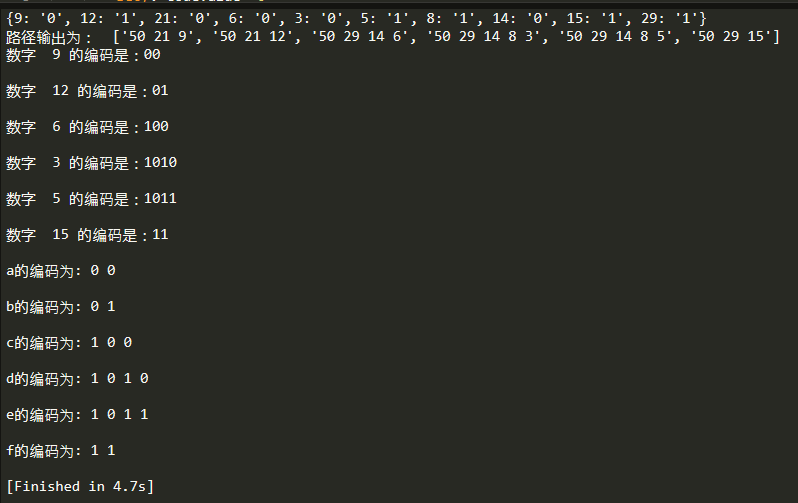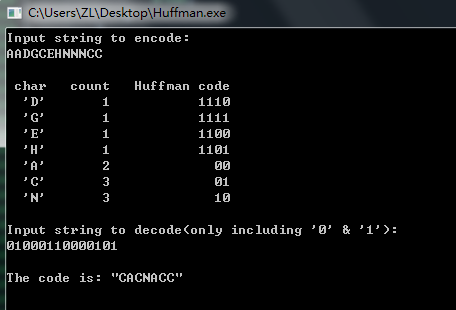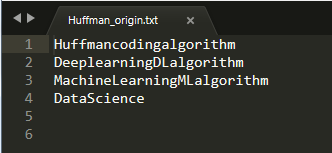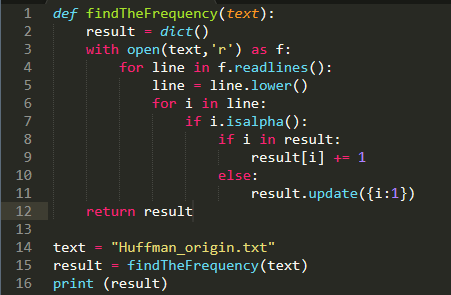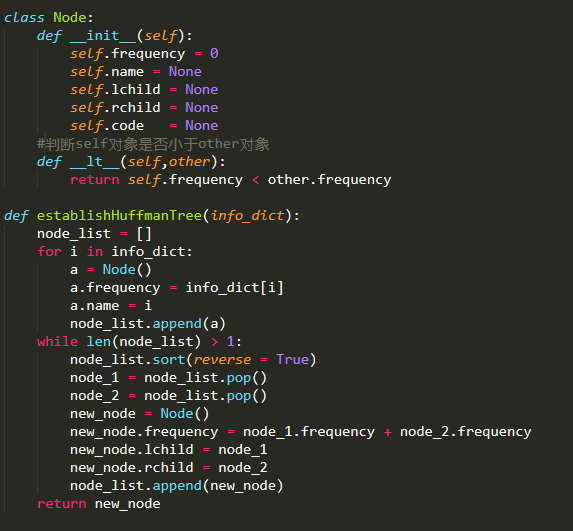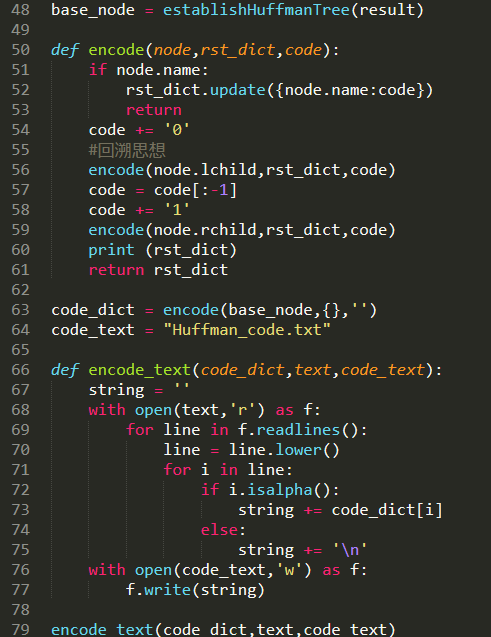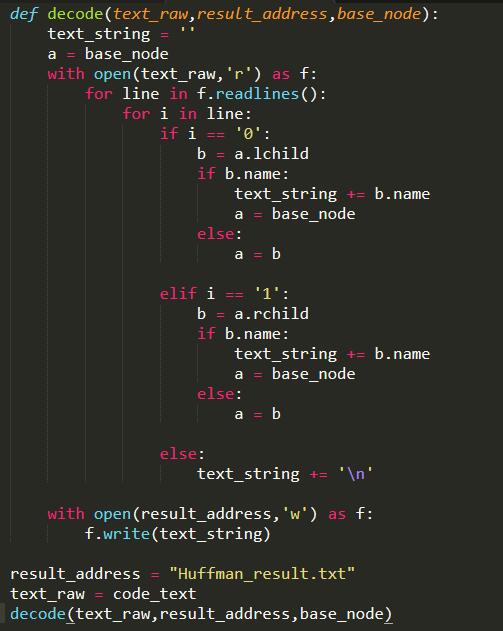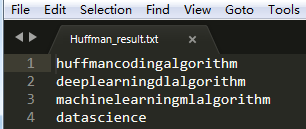1.完整代码——Python语言实现:
#节点类,当树中叶节点最大数为n时,霍夫曼树的总节点数为2n-1
class Node(object):
def __init__(self,name=None,value=None):
self._name=name
self._value=value
self._left=None
self._right=None
self._codevalue='0'
#哈夫曼树类
class HuffmanTree(object):
#根据Huffman树的思想:以叶子节点为基础,反向建立Huffman树
def __init__(self,char_weights):
self.codeway = {}#存储节点对应的编码数,1or0
self.a=[Node(part[0],part[1]) for part in char_weights] #根据输入的字符及其频数生成叶子节点
while len(self.a)!=1:#如果没有到达根节点
self.a.sort(key=lambda node:node._value,reverse=True)#根据节点的value进行从大到小的排序
c=Node(value=(self.a[-1]._value+self.a[-2]._value))#对于权值最小的两个节点相加作为新节点c的value
c._left=self.a.pop(-1)#把排序完的树叶节点挂靠在c上,作为左右节点
c._right=self.a.pop(-1)
self.a.append(c)#bac作为节点连在树上
self.root=self.a[0]
#方法一
def pre(self, tree, length,l):
if l==0:
self.b=[0]*length
node = tree
if (not node):
return
elif node._name:
print(node._name + '的编码为:',end=' ')
for i in range(l):
print(self.b[i],end=' ')
print('\n')
return
#是树的左子节点的话赋值为0,直到到达叶结点之后print了编码,再对考虑右子树
self.b[l] = 0
self.pre(node._left, length,l + 1)
self.b[l] = 1
self.pre(node._right,length,l + 1)
#方法二
# 函数得到每一个叶结点的路径
def binaryTreePaths(self, root):
if not root:#如果root不存在
return []
if not root._left and not root._right:#如果root就是一个叶节点
return [str(root._value)]
pathList = []#用来存储路径
if root._left:#沿左子树下行递归遍历直到到达了叶节点
root._left._codevalue = '0'
pathList+=self.binaryTreePaths(root._left)
self.codeway[root._left._value]=root._left._codevalue
if root._right:
root._right._codevalue='1'
pathList+=self.binaryTreePaths(root._right)
self.codeway[root._right._value] = root._right._codevalue
for index, path in enumerate(pathList):#枚举pathList,得到对应节点路径的存放路径
pathList[index]=str(root._value) + ' ' + path
# for index,path in enumerate(self.codeway):
# self.codeway[index] =str(root._codevalue) + ' ' + path
# print(root._value,root._codevalue)
#用这个打印每一节点对应的编码
return pathList
#生成哈夫曼编码
def code_way(self):
return self.codeway
if __name__=='__main__':
#输入的是字符及其频数
char_weights=[('a',9),('b',12),('c',6),('d',3),('e',5),('f',15)]
tree=HuffmanTree(char_weights)
length=len(char_weights)
#方法二
pathList = tree.binaryTreePaths(tree.root)
codeway=tree.code_way()
print(codeway)
print("路径输出为: ",pathList)
for i in pathList:
i=i.split(' ')[1:]#根节点不参与编码,所以切掉
print("数字 ",i[-1],"的编码是:",end='')
for j in i:
print(codeway[int(j)],end='')
print('\n')
#方法一
tree.pre(tree.root,length,0)
运行结果:
2.完整代码——C语言实现:
#include <stdio.h>
#include <stdlib.h>
#include <string.h>
#include <conio.h>
#define MAX_CHAR_KINDS 128//字符种类最大值。。
#define MAX_NUM 1000//字符串最大长度。。
FILE *in, *ou;
typedef struct TreeNode
{
int weight;
int id;
short isLeaf;
char data;
char bin;//0或者1。。
struct TreeNode *parent;
struct TreeNode *lChild, *rChild;
} TreeNode;
typedef struct
{
char data;
char code[MAX_CHAR_KINDS];
} Code;
//字符串倒置。。
void ReverseStr(char *str)
{
int i;
char c;
int length;
length = strlen(str);
for (i = 0; i < length / 2; i++)
{
c = str[length - 1 - i];
str[length - 1 - i] = str[i];
str[i] = c;
}
}
void PreOrderTraverse(TreeNode *t)
{
if ((t->rChild == NULL) && (t->lChild == NULL))
{
t->isLeaf = 1;
}
else
{
t->isLeaf = 0;
}
if (t->parent != NULL)
{
t->id = 2 * t->parent->id + (int)t->bin - 48;
}
else
{
t->id = 1;
t->bin = ' ';
}
if (t->isLeaf == 1)
{
fprintf(ou, "%6d%5c%8d '%c'\n", t->id, t->bin, t->isLeaf, t->data);
}
else
{
fprintf(ou, "%6d%5c%8d\n", t->id, t->bin, t->isLeaf);
}
if (t->lChild != NULL)
{
PreOrderTraverse(t->lChild);
}
if (t->rChild != NULL)
{
PreOrderTraverse(t->rChild);
}
}
int main()
{
char str[MAX_NUM];
char pwd[MAX_NUM];
TreeNode *HFTree;
int i, j;
int length;//字符串长度。。
int count;//不同字符个数。。
TreeNode *tree[MAX_CHAR_KINDS];//初始的几个小树。。
TreeNode *eachChar[MAX_CHAR_KINDS];
TreeNode *temp, *p;
Code *HFCode;
int codeBit;
short existed;
//输入,初始化。。
printf("Input string to encode:\n");
gets(str);
printf("\n");
length = strlen(str);
count = 0;
//开始统计字符串中各个字符出现的次数。。
for (i = 0; i < length; i++)
{
existed = 0;
for (j = 0; j < count; j++)
{
if (str[i] == tree[j]->data)
{
tree[j]->weight++;
existed = 1;
break;
}
}
//如果不是现有的字符,拿个新盒子装。。
if (existed == 0)
{
tree[count] = (TreeNode *)malloc(sizeof(TreeNode));
tree[count]->weight = 1;
tree[count]->data = str[i];
tree[count]->parent = NULL;
tree[count]->lChild = NULL;
tree[count]->rChild = NULL;
eachChar[count] = tree[count];//备份。。
count++;
}
}
//非法输入。。
if (count == 0)
{
printf("No char!\n");
getch();
return (0);
}
else if (count == 1)
{
printf("At least 2 kinds of char!\n");
getch();
return (0);
}
//冒泡,升序。。
for (i = 0; i < count - 1; i++)
{
for (j = 0; j < count - 1 - i; j++)
{
if (tree[j]->weight > tree[j+1]->weight)
{
temp = tree[j];
tree[j] = tree[j+1];
tree[j+1] = temp;
}
}
}
//生成Huffman树。。
for (i = 1; i < count; i++)
{
temp = (TreeNode *)malloc(sizeof(TreeNode));
temp->lChild = tree[i-1];
temp->rChild = tree[i];
temp->parent = NULL;
temp->weight = tree[i-1]->weight + tree[i]->weight;
tree[i-1]->parent = temp;
tree[i-1]->bin = '0';
tree[i]->parent = temp;
tree[i]->bin = '1';
tree[i] = temp;
for (j = i; j < count - 1; j++)
{
if (tree[j]->weight > tree[j+1]->weight)
{
temp = tree[j];
tree[j] = tree[j+1];
tree[j+1] = temp;
}
else
{
break;
}
}
}
HFTree = tree[count-1];
//保存Huffman Tree到HuffmanTree.txt文件中。。
if ((ou = fopen("HuffmanTree.txt", "w")) == NULL)
{
printf("Cannot open file HuffmanTree.txt\n");
getch();
exit(0);
}
fprintf(ou, "%6s%5s%8s%6s\n", "NodeID", "Bin", "IsLeaf", "Data");
PreOrderTraverse(HFTree);
fclose(ou);
//冒泡后求各个字符的哈夫曼编码。。
for (i = 0; i < count - 1; i++)
{
for (j = 0; j < count - 1 - i; j++)
{
if (eachChar[j]->weight > eachChar[j+1]->weight)
{
temp = eachChar[j];
eachChar[j] = eachChar[j+1];
eachChar[j+1] = temp;
}
}
}
HFCode = (Code *)malloc(count * sizeof(Code));
for (i = 0; i < count; i++)
{
temp = eachChar[i];
HFCode[i].data = temp->data;
codeBit = 0;
while (temp->parent != NULL)
{
HFCode[i].code[codeBit] = temp->bin;
temp = temp->parent;
codeBit++;
}
HFCode[i].code[codeBit] = '\0';
ReverseStr(HFCode[i].code);
}
//输出,同时保存到HuffmanCode.txt文件里。。
if ((ou = fopen("HuffmanCode.txt", "w")) == NULL)
{
printf("Cannot open file HuffmanCode.txt\n");
getch();
exit(0);
}
printf("%5s%8s%15s\n", "char", "count", "Huffman code");
fprintf(ou, "%5s%8s%15s\n", "char", "count", "Huffman code");
for (i = 0; i < count; i++)
{
printf(" '%c'%8d%15s\n", eachChar[i]->data, eachChar[i]->weight, HFCode[i].code);
fprintf(ou, " '%c'%8d%15s\n", eachChar[i]->data, eachChar[i]->weight, HFCode[i].code);
}
printf("\n");
fclose(ou);
//解码。。
printf("Input string to decode(only including '0' & '1'):\n");
gets(str);
length = strlen(str);
p = HFTree;
j = 0;
codeBit = 0;
for (i = 0; i < length; i++)
{
if (str[i] == '0')
{
p = p->lChild;
}
else if (str[i] == '1')
{
p = p->rChild;
}
else
{
printf("\nInput illegal..\n");
getch();
exit(0);
}
if ((p->lChild == NULL) && (p->lChild == NULL))
{
pwd[codeBit] = p->data;
p = HFTree;
codeBit++;
}
}
pwd[codeBit] = '\0';
printf("\nThe code is: \"%s\"\n", pwd);
getch();
return (0);
}
运行结果:
3.步骤分解:
原始text文件:
1.以字典的形式统计每个字母出现的频率:
2.创建Huffman树.首先定义一个节点的类,包含名称,概率,左子节点和右子节点
输入的是上一步输出的概率表
输出的是Huffman树的根节点,因为只要知道根节点,其实整棵树的信息就都知道了
3.根据Huffman树进行编码
运行结果:
4.解码,根据编码返回文本
解码的结果:
完整代码:
def findTheFrequency(text):
result = dict()
with open(text,'r') as f:
for line in f.readlines():
line = line.lower()
for i in line:
if i.isalpha():
if i in result:
result[i] += 1
else:
result.update({i:1})
return result
text = "Huffman_origin.txt"
result = findTheFrequency(text)
class Node:
def __init__(self):
self.frequency = 0
self.name = None
self.lchild = None
self.rchild = None
self.code = None
#判断self对象是否小于other对象
def __lt__(self,other):
return self.frequency < other.frequency
def establishHuffmanTree(info_dict):
node_list = []
for i in info_dict:
a = Node()
a.frequency = info_dict[i]
a.name = i
node_list.append(a)
while len(node_list) > 1:
node_list.sort(reverse = True)
node_1 = node_list.pop()
node_2 = node_list.pop()
new_node = Node()
new_node.frequency = node_1.frequency + node_2.frequency
new_node.lchild = node_1
new_node.rchild = node_2
node_list.append(new_node)
return new_node
base_node = establishHuffmanTree(result)
def encode(node,rst_dict,code):
if node.name:
rst_dict.update({node.name:code})
return
code += '0'
#回溯思想
encode(node.lchild,rst_dict,code)
code = code[:-1]
code += '1'
encode(node.rchild,rst_dict,code)
print (rst_dict)
return rst_dict
code_dict = encode(base_node,{},'')
code_text = "Huffman_code.txt"
def encode_text(code_dict,text,code_text):
string = ''
with open(text,'r') as f:
for line in f.readlines():
line = line.lower()
for i in line:
if i.isalpha():
string += code_dict[i]
else:
string += '\n'
with open(code_text,'w') as f:
f.write(string)
encode_text(code_dict,text,code_text)
def decode(text_raw,result_address,base_node):
text_string = ''
a = base_node
with open(text_raw,'r') as f:
for line in f.readlines():
for i in line:
if i == '0':
b = a.lchild
if b.name:
text_string += b.name
a = base_node
else:
a = b
elif i == '1':
b = a.rchild
if b.name:
text_string += b.name
a = base_node
else:
a = b
else:
text_string += '\n'
with open(result_address,'w') as f:
f.write(text_string)
result_address = "Huffman_result.txt"
text_raw = code_text
decode(text_raw,result_address,base_node)
点击查看更多内容
为 TA 点赞
评论
共同学习,写下你的评论
评论加载中...
作者其他优质文章
正在加载中
感谢您的支持,我会继续努力的~
扫码打赏,你说多少就多少
赞赏金额会直接到老师账户
支付方式
打开微信扫一扫,即可进行扫码打赏哦


